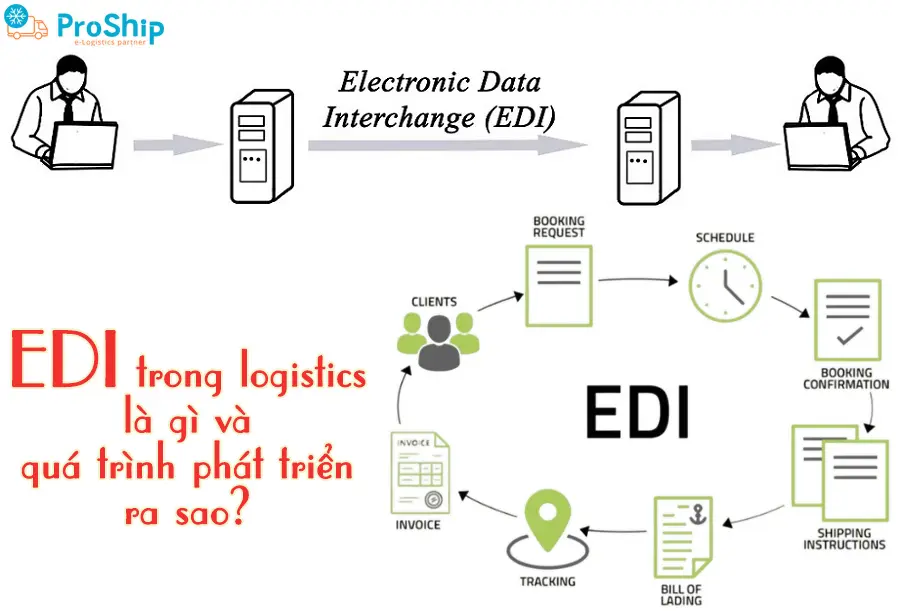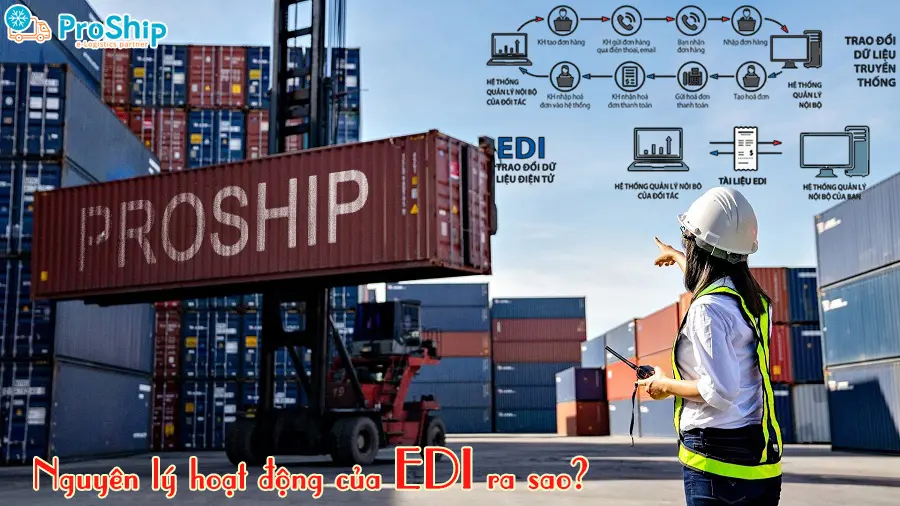EDI (Electronic Data Interchange) trong logistics là phương thức trao đổi điện tử các chứng từ như đơn đặt hàng, hóa đơn, vận đơn giữa các bên một cách tự động, chuẩn hóa và nhanh chóng. Doanh nghiệp nào ứng dụng EDI sẽ giảm sai sót nhập liệu, nâng cao tốc độ xử lý đơn hàng và tiết kiệm chi phí giấy tờ đáng kể. Bài viết này Proship.vn sẽ giúp bạn hiểu rõ EDI trong logistics là gì, vai trò trong quản trị chuỗi cung ứng và cách hoạt động của nó. Cùng khám phá ngay nhé!
EDI trong logistics là gì? Viết tắt của từ gì? Quá trình phát triển EDI ra sao?
Cùng Proship tìm đọc nội dung sau để biết EDI là viết tắt của từ gì và quá trình phát triển ra sao:
EDI trong logistics là gì?
EDI trong logistics là gì? EDI trong logistics là viết tắt của cụm từ tiếng Anh “Electronic Data Interchange”. Với các doanh nghiệp, EDI là phương thức trao đổi thông tin và tài liệu kinh doanh như: Đơn đặt hàng, Hóa đơn, Thông tin vận chuyển,…giữa các đối tác với nhau.

Quá trình phát triển của EDI
Năm 1960, EDI bắt đầu được sử dụng ở dạng cơ bản, dùng để trao đổi thông tin giữa Công ty này với Công ty khác bằng phương tiện điện tử. Công nghệ EDI giúp thúc đẩy quá trình hoàn thành công việc của các Tổ chức thương mại và hạn chế tối đa các lỗi do thủ công gây ra bằng cách tự động hóa mọi thông tin liên lạc giữa các doanh nghiệp (B2B).
Ứng dụng của EDI trong logistics và quản trị chuỗi cung ứng
Ứng dụng của EDI trong logistics là gì? EDI trong quản lý chuỗi cung ứng được sử dụng để sắp xếp việc chuyển tài liệu như vận đơn (B/L – Bill of Lading), chứng từ hải quan, trạng thái vận chuyển, hướng dẫn định tuyến, hóa đơn và nhiều các văn bản khác liên quan. EDI có những đóng góp quan trọng cho thị trường xuất nhập khẩu, cụ thể:
EDI góp phần quản lý tốt hàng tồn kho
EDI giúp doanh nghiệp duy trì mức dự trữ hàng tồn kho bằng cách cung cấp quyền truy cập vào các bản cập nhật theo thời gian thực và xu hướng thị trường mới nhất. Từ đó, doanh nghiệp có thể sử dụng để hợp lý hóa việc phân bổ nguồn lực hợp lý, quản lý mức độ thiếu hụt hoặc dư thừa hàng tồn kho.
EDI góp phần nâng cao hiệu quả giao tiếp
Giao dịch thành công khi đạt được thông tin liên lạc tức thì, an toàn và hiệu quả không chỉ giữa nơi xuất xứ và điểm đến cuối cùng của sản phẩm mà còn là giữa nhà sản xuất với nhà phân phối. Không chỉ về liên lạc vật lý mà còn liên quan đến thông tin và dữ liệu, từ đó thúc đẩy liên kết của các mắt xích chuỗi cung ứng.
EDI đối với nhà khai thác dịch vụ logistics
EDI tích hợp các hoạt động đường biển, đường bộ, đường hàng không trong cùng một luồng liên lạc và trong quản lý các cảng vận chuyển, hải quan,…

EDI giúp thông điệp được chuẩn hóa
Việc trao đổi thông tin điện tử qua EDI sử dụng một ngôn ngữ chuẩn hóa, được chia sẻ bởi người gửi và người nhận. Nhờ sử dụng một ngôn ngữ chung mà các hệ thống thông tin khác nhau tương tác với nhau sẽ vượt qua rào cản ngôn ngữ và kỹ thuật.
EDI đối với nhà phân phối
EDI giúp lập kế hoạch cho chuỗi cung ứng, kiểm soát tốt hàng tồn kho với những sản phẩm dễ hư hỏng.
EDI trong quản lý Hải quan, PIF
EDI góp phần hợp lý hóa và cung cấp các thủ tục hành chính an toàn.
EDI đóng vai trò quan trọng ra sao với doanh nghiệp?
Lợi ích của EDI trong logistics là gì? Lợi ích kinh doanh mà công nghệ EDI mang lại thông qua tự động hóa và tích hợp B2B là:
Tiết kiệm chi phí cho doanh nghiệp
EDI thay thế cho các phương thức trao đổi thủ công thông thường. So với những phương thức nhập liệu, in ấn, sao chép hay xử lí hồ sơ thủ công, việc ứng dụng EDI giúp doanh nghiệp tiết kiệm phần lớn chi phí giấy tờ, thư tín. Bên cạnh đó, doanh nghiệp cũng tiết kiệm được thời gian vì không cần nhập lại thông tin nhiều lần.
Nâng cao hiệu quả và độ chính xác cho giao dịch
EDI giúp hạn chế rủi ro như lỗi nhập liệu mà phương thức thủ công trước đây hay mắc phải. Ngoài ra còn rút gọn thời gian chuyển dòng tiền mặt, cải thiện các giao dịch kinh doanh và các mối quan hệ đối tác, khách hàng. Hệ thống lưu trữ EDI cũng giúp văn bản đã được giao đến đối tác và có thể theo dõi lộ trình, đường đi của hàng hóa trong từng giai đoạn.
Tăng hiệu quả kinh doanh
Khi EDI được sử dụng thuần thục, đồng nghĩa với việc doanh nghiệp sẽ hoạt động trơn tru, nhanh và hiệu quả hơn từ việc tiếp cận khách hàng, xây dựng mối quan hệ với đối tác đến việc hoàn tất chứng từ cần thiết nhanh chóng.
Cụ thể, EDI giúp doanh nghiệp giảm sai sót trong hóa đơn, cập nhật realtime tình trạng đơn hàng,…từ đó có thể nâng cao khả năng cạnh tranh so với các đối thủ.
Kết nối rộng hơn với các doanh nghiệp trên thế giới
Doanh nghiệp có thể trao đổi trực tiếp với các Công ty nước ngoài dễ hơn (khi cả 2 đều sử dụng công nghệ EDI). Điều này giúp doanh nghiệp trong nước có thể mở rộng hợp tác với các Công ty lớn hay dễ dàng cho quá trình xuất nhập khẩu.
Quy trình, nguyên lý hoạt động của EDI ra sao?
Nguyên lý hoạt động của EDI như sau:
Giai đoạn 1 – Chuẩn bị tài liệu điện tử
Bên gửi dữ liệu chuẩn bị tài liệu điện tử để gửi đi. Dữ liệu này sẽ được mã hóa chuẩn EDI bằng hệ thống phần mềm của họ để đảm bảo an toàn và bảo mật dữ liệu trong quá trình truyền tải.
Giai đoạn 2 – Dịch dữ liệu
Dữ liệu cần truyền tải sẽ được dịch và chuẩn bị để truyền qua các phương tiện điện tử. Bộ chuyển đổi EDI sẽ dịch và chuẩn bị dữ liệu này.

Giai đoạn 3 – Truyền tải dữ liệu
Dữ liệu EDI được truyền thông qua mạng Internet công cộng hoặc truyền qua mạng giá trị gia tăng (Value Added Network – VAN) – mạng đặc biệt được thiết kế để hỗ trợ việc truyền tải dữ liệu EDI.
Giai đoạn 4 – Dịch dữ liệu nhận được
Phía bên nhận dữ liệu sẽ dùng hệ thống phần mềm của mình để dịch dữ liệu nhận được từ bên gửi. Quá trình này dựa trên các chuẩn EDI đã được quy định để đảm bảo sự nhất quán và hiểu được dữ liệu truyền tới.
Giai đoạn 5 – Xử lý dữ liệu
Dữ liệu sau khi được dịch sẽ được chuyển đến hệ thống điện tử để xử lý. Quá trình này gồm việc cập nhật hệ thống thông tin, xử lý đơn hàng hay các hoạt động kinh doanh khác phụ thuộc vào mục đích sử dụng dữ liệu.
Câu hỏi thường gặp
1. EDI là gì trong logistics?
EDI là viết tắt của Electronic Data Interchange – phương thức trao đổi dữ liệu chứng từ giữa các đối tác kinh doanh (hóa đơn, vận đơn, chứng từ hải quan…) bằng định dạng điện tử chuẩn hóa.
2. Ưu điểm của việc áp dụng EDI cho doanh nghiệp logistics là gì?
Giúp giảm sai sót nhập liệu, rút ngắn thời gian xử lý giấy tờ, quản lý tồn kho tốt hơn, tăng độ chính xác & tính minh bạch trong giao dịch.
3. Ứng dụng của EDI trong hải quan & logistics quốc tế như thế nào?
EDI được dùng để gửi chứng từ hải quan, thông báo vận đơn, trạng thái hàng hóa, dữ liệu PIF… giúp quy trình xuất nhập khẩu và kiểm soát hải quan diễn ra nhanh và chính xác hơn.
4. Quy trình hoạt động của EDI là ra sao?
Gồm các bước: chuẩn bị tài liệu điện tử – dịch dữ liệu theo chuẩn EDI – truyền tải qua mạng an toàn – bên nhận dịch dữ liệu – xử lý trong hệ thống của bên nhận.
5. Làm sao doanh nghiệp có thể bắt đầu sử dụng EDI?
Cần có hệ thống phần mềm hỗ trợ chuẩn EDI, kết nối với đối tác (nhà cung cấp, khách hàng, hải quan), hợp đồng trao đổi dữ liệu và chuẩn hóa format. Việc này có thể đòi hỏi đầu tư bước đầu nhưng có lợi lâu dài về chi phí và hiệu suất.
EDI trong logistics là gì cùng những kiến thức liên quan tới Electronic Data Interchange, vai trò của EDI trong logistics và quản trị chuỗi cung ứng đã được Proship Logistics chia sẻ. Theo đó, nếu các doanh nghiệp XNK đang tham gia vào quản trị chuỗi cung ứng và có kế hoạch ứng dụng công nghệ EDI vào công việc nên cập nhật nội dung trên. Liên hệ ngay 0909 344 247 khi có nhu cầu sử dụng Dịch vụ KBHQ, Cho thuê kho ngoại quan, Dịch vụ vận tải Đa phương thức, Dịch vụ vận chuyển container Bắc Nam, Trucking container liên vận quốc tế tại Proship.

